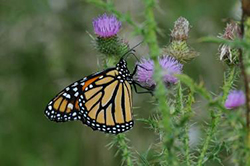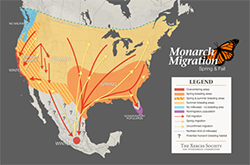
USFWS Photo by Brett Billings

Figure 1 from The Xerces Society’s  Conservation Status and Ecology of the Monarch Butterfly in the United States (PDF)
Conservation Status and Ecology of the Monarch Butterfly in the United States (PDF)
For residents of many coastal California towns, the colorful Monarch butterfly (Danaus plexippus plexippus) migration has been a welcome wintertime sight for generations. The beautiful and distinctive orange-and-black patterned insects have historically congregated at more than 400 known sites in the Golden State. Visitors flock to see them, and some towns – such as Pacific Grove, Big Sur and Pismo Beach -- have built entire economies around the return of the butterflies.
The life history of the Monarch butterfly is fascinating in that none of the individuals that arrive each winter have ever been there before. Each year, the Monarchs that were born throughout western North America flutter to the warmer climates of the California coast, typically in mid-October, but sometimes as early as September. They form dense masses high in the trees, where they remain relatively dormant (scientifically known as reproductive diapause) until February or March, when flowers with nectar and the milkweed needed by their young (caterpillars) become plentiful. At that time, they mate and begin to disperse and lay their eggs. The offspring then grow into butterflies, which in turn mate and lay eggs while continuing to disperse over a two to five week period. The process continues until fall when temperatures drop, triggering migration of the current generation of butterflies back to the west coast.
As recently as the 1990s, an estimated 1 million butterflies would overwinter along the California coast each year. But over the past several decades, that figure has rapidly plummeted. Recently, the Xerces Society, an international nonprofit focused on the conservation of invertebrates and their habitats, released the results of its Western Monarch Thanksgiving Count, and the news is dire – just 28,429 overwintering Monarchs were counted in California, which is an 86 percent decrease from the count at the same time the previous year.
Washington, Oregon, Idaho, Utah, Nevada and Arizona are seeing similar drops in numbers during the breeding season.
“In addition to fewer monarchs, we’re losing the phenomenon of the migratory behavior,” explains Karen Miner, chief of CDFW’s Biogeographic Data Branch. Miner serves as the chair of the Western Monarch Working Group, a task force consisting of biologists from the seven state agencies. The biologists have been working with experts for months to identify possible causes of the decline, as well as actions that could be undertaken to encourage Monarch population growth.
Unfortunately, there are no easy answers, or easy solutions. According to the Xerces Society report, “the factors that influence Monarch population dynamics in the Western U.S. are still not completely understood.”
In California, some specific factors contributing to the decline of the Monarchs include:
- Loss of overwintering habitat along the coast. Favorable weather conditions along the California coast attract people as well as the butterflies, and urban development has removed or crowded many of the sites traditionally used by monarchs in the winter. Many of these sites feature eucalyptus trees, originally introduced from Australia in the 1800s. These towering giants historically provided shelter to overwintering Monarchs. But now, the trees are dying of old age as well as the effects of recent drought conditions and disease. Nectaring plants that provide food for overwintering butterflies are also becoming scarce. Protecting and restoring these coastal sites to meet the needs of wintering Monarchs is a top conservation need.
- The loss of native milkweeds and flowering plants, particularly in the areas where the first eggs would be laid in the spring. Milkweed is a Monarch staple. Butterflies lay their eggs on it, and the emerging caterpillars use it as a food source. Adult butterflies rely on flower nectar for their source of food. As with overwintering habitat, development and land management practices have reduced the amount of milkweed and nectar sources available for Monarchs and other pollinators. Many nurseries and hardware stores sell milkweed, which seems like a Monarch-friendly practice on the surface. But much of the milkweed that’s commercially available to gardeners is non-native, and scientists have noticed that the butterflies attracted to it are more prone to disease, and less likely to migrate to overwintering sites.
- Complications of a changing climate. Based on annual counts at overwintering sites, the Monarchs that do overwinter are arriving later and leaving earlier. Scientists are concerned that food resources and milkweed for egg laying are not yet available for the Monarchs when they need it. CDFW urges the public to report sightings of Monarchs and the plants they are feeding on to
 Western Monarch Milkweed Mapper. This tool, which also allows citizen scientists to upload photos, will help biologists better understand the distribution and life cycle of both the butterflies and their host plants.
Western Monarch Milkweed Mapper. This tool, which also allows citizen scientists to upload photos, will help biologists better understand the distribution and life cycle of both the butterflies and their host plants.
“Can we reverse this? It’s a complicated issue, and it’s going to be hard,” Miner says. “We need to take a number of different approaches. We have to protect overwintering groves, educate the landowners and neighbors of these sites, and we need to improve pollinator habitat including milkweed availability. Each state in the west has a role to play, and so many people can contribute to this effort – citizen scientists, educators, garden club members, agricultural growers, and rights-of-way managers such as utilities or transportation agencies.”
The US Fish and Wildlife Service is currently reviewing a petition to list the monarch under the Endangered Species Act, but the member states of the Monarch Working Group are wasting no time in moving forward with their own efforts to conserve the butterflies. At a meeting of the Western Association of Fish and Wildlife Agencies in January, the group finalized its  Western Monarch Butterfly Conservation Plan (PDF), which establishes population size and habitat conservation goals, strategies and specific actions. Specific goals include creating an additional 50,000 acres of Monarch-friendly habitat in the Central Valley and foothills, establishing protection and management for half of all currently known overwintering sites, and, ultimately, achieving an average count of 500,000 overwintering butterflies in the west by 2029.
Western Monarch Butterfly Conservation Plan (PDF), which establishes population size and habitat conservation goals, strategies and specific actions. Specific goals include creating an additional 50,000 acres of Monarch-friendly habitat in the Central Valley and foothills, establishing protection and management for half of all currently known overwintering sites, and, ultimately, achieving an average count of 500,000 overwintering butterflies in the west by 2029.
Photos courtesy of USFWS and Xerces Society. Top Photo: USFWS Photo by Ryan Hagerty
###
Media Contact:
Kirsten Macintyre, CDFW Communications, (916) 322-8988
Kyle Orr, CDFW Communications, (916) 322-8958